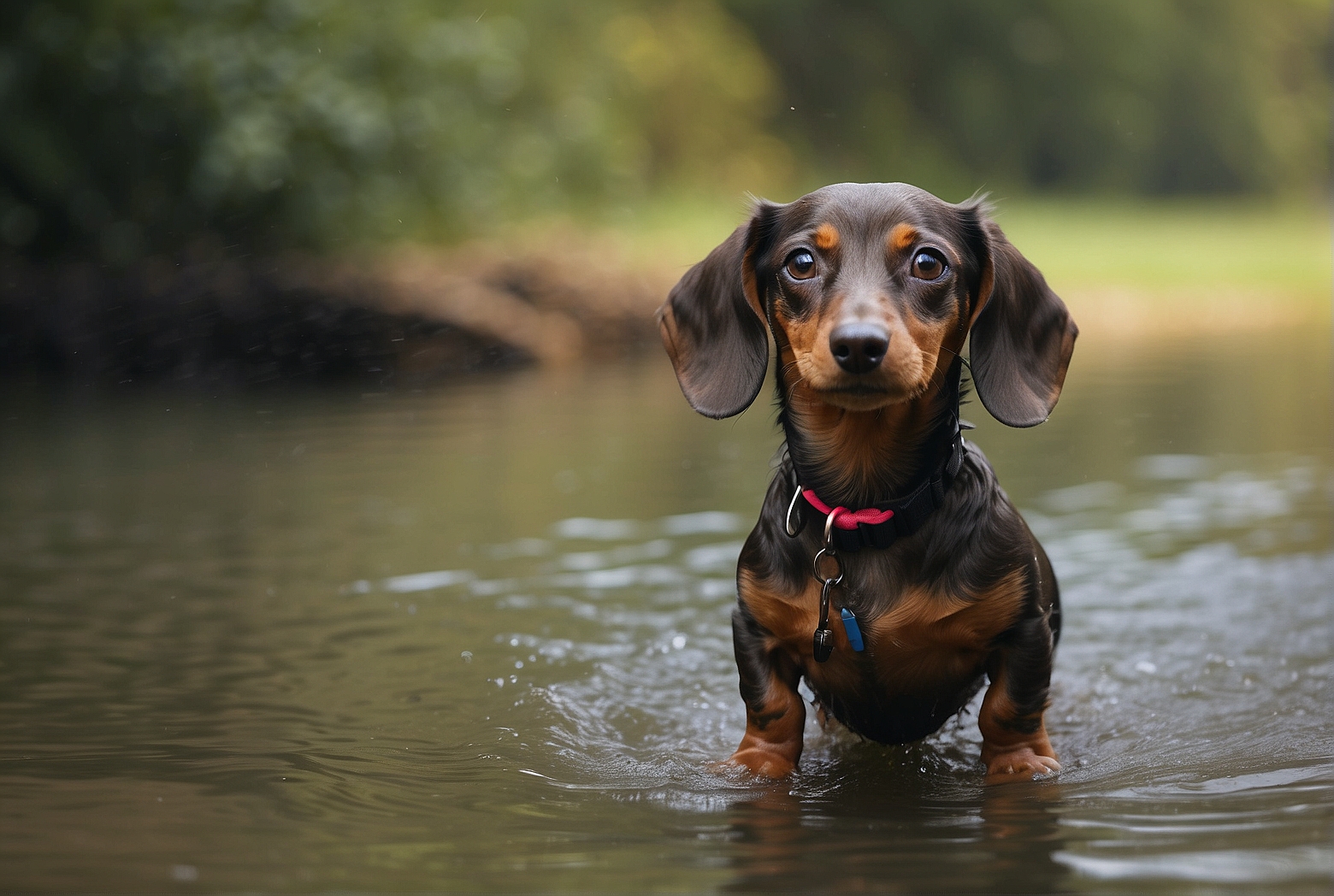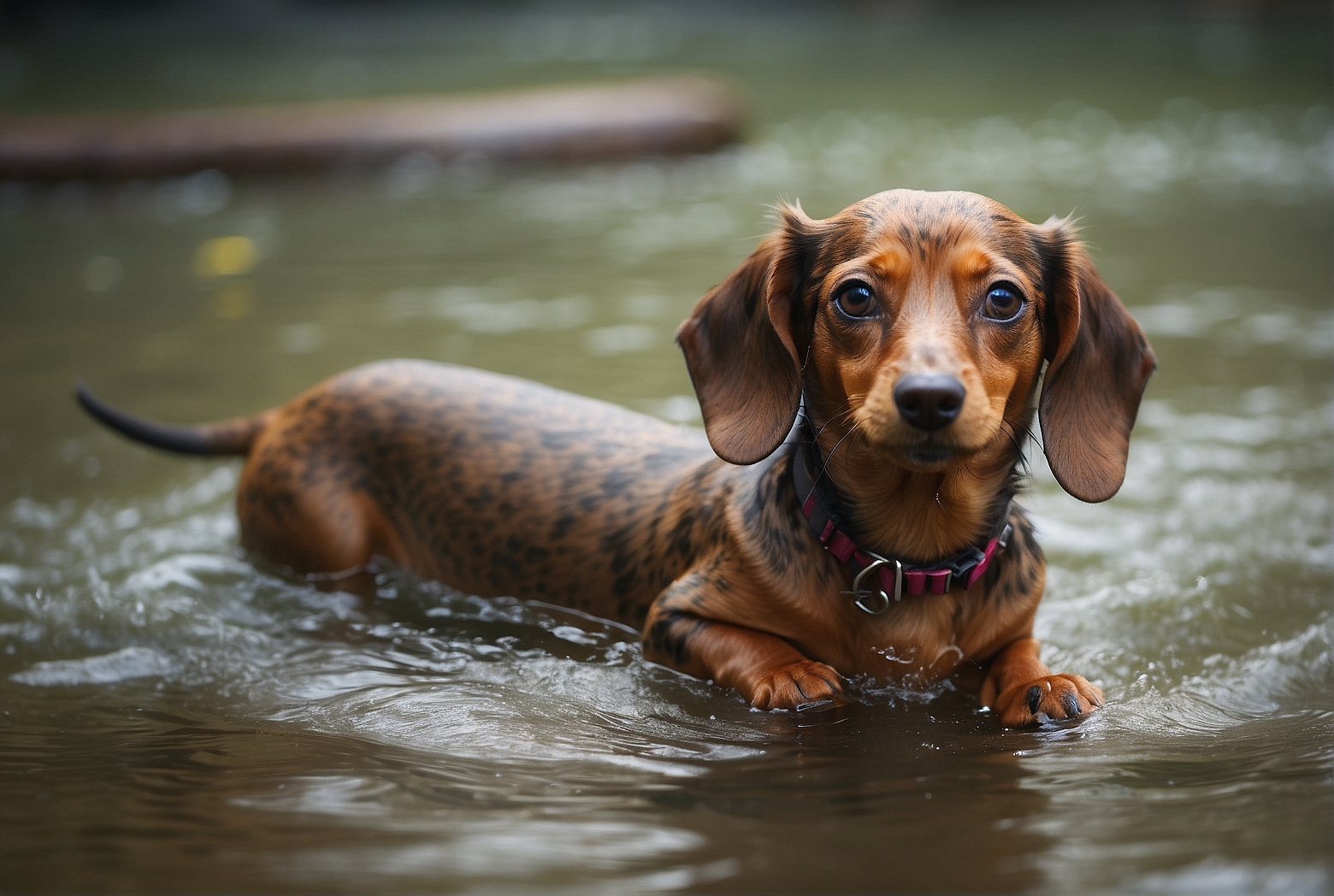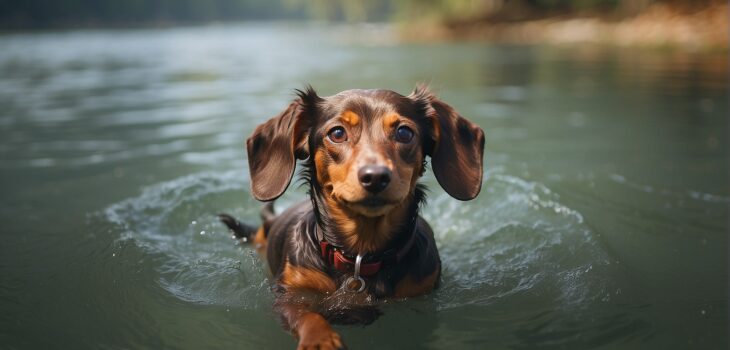You may have seen these adorable, long-bodied pups wiggling their way through life, but have you ever wondered if dachshunds can swim? With their short legs and elongated bodies, the idea of these little sausages making a splash might seem unlikely. However, surprisingly enough, these lovable dachshunds are more than just land-lovers. Can dachshunds swim? Let’s explore the aquatic abilities of these courageous canines and uncover the truth behind their aquatic adventures.
Dachshund Anatomy
Physical Characteristics
Dachshunds are a small breed of dog known for their unique physical characteristics. They have a long body, short legs, and a tail that is in proportion to their body size. Because of their elongated shape, dachshunds are often referred to as “wiener dogs” or “sausage dogs.” Their small size and distinctive body structure make them well-suited for certain activities, including swimming.
Body Structure
The body structure of a dachshund plays a vital role in their swimming abilities. Their long, muscular bodies are built low to the ground, which helps them move through the water with relative ease. The shape of their body allows them to propel themselves forward using their strong hindquarters. Their front legs are short, but they are surprisingly powerful, enabling the dachshund to maintain balance and stability while swimming.
Natural Swimming Instincts
Historical Background
Dachshunds have a long history of being associated with hunting, specifically for small game like badgers. They were originally bred in Germany, where their unique body shape and swimming abilities were highly valued. In fact, the name “dachshund” translates to “badger dog” in German. Their ancestors were skilled at navigating through various terrains, including water, which is why dachshunds have a natural instinct for swimming.

Water-Resistant Coat
One of the reasons dachshunds excel at swimming is their water-resistant coat. Their short, dense fur acts as a barrier, preventing water from saturating their skin. This characteristic allows them to swim more comfortably and efficiently without getting weighed down by excess water. Additionally, their double coat provides insulation, keeping them warm even in colder water temperatures.
Paddle-Like Paws
Another notable feature of a dachshund’s anatomy that contributes to their swimming ability is their paddle-like paws. Their broad, webbed toes allow them to generate more propulsion in the water, similar to a swimmer’s flippers. This paw structure enhances their swimming capabilities, making them more agile and efficient in the water.
Muscular Hindquarters
Dachshunds have well-developed, muscular hindquarters that provide them with the power and strength needed for swimming. These muscles enable them to paddle and kick effectively, propelling them through the water. The combination of their strong hindquarters and unique body shape gives dachshunds an advantage when it comes to swimming compared to other dog breeds.
Dachshunds and Water Safety
Supervised Environment
While dachshunds have a natural affinity for swimming, it is crucial to ensure their safety when they are in or near bodies of water. Supervision is essential to prevent accidents and to address any potential risks. Whether it’s a pool, lake, or any other aquatic environment, it is important to keep a close eye on your dachshund to ensure they remain safe and secure.

Life Jackets
To provide an extra layer of safety for your dachshund, consider investing in a properly fitted life jacket. Life jackets designed for dogs come in various sizes and provide buoyancy to help keep your dachshund afloat in the water. This can be particularly beneficial if you plan on taking your dachshund on boat trips or in deep bodies of water where they may need additional support to stay safe.
Training and Conditioning
Before introducing your dachshund to swimming, it is essential to establish a foundation of training and conditioning. This includes obedience training and teaching basic commands such as “come” and “stay.” Additionally, gradually exposing your dachshund to water environments and providing positive reinforcement can help build their confidence and trust. Conditioning exercises, such as walking or playing in shallow water, can also help strengthen their muscles and improve their swimming abilities.
Common Concerns and Misconceptions
Spinal Health
One of the most common concerns associated with dachshunds and swimming is the potential impact on their spinal health. Dachshunds are prone to back problems due to their long bodies and short legs, a condition known as intervertebral disc disease (IVDD). While it is true that certain dachshunds may be more susceptible to spinal issues, swimming can actually be beneficial for their overall muscle strength and core stability. However, it is crucial to consult with a veterinarian before allowing your dachshund to swim, especially if they have pre-existing back or spinal conditions.
Risk of Injury
Like any physical activity, swimming carries a certain level of risk for dogs. Dachshunds, in particular, may be at a higher risk of injury due to their body structure. It is important to be cautious and avoid any activities that could potentially harm your dachshund, such as jumping from high surfaces into the water or engaging in rough play with other dogs. Being attentive to your dachshund’s movements and taking necessary precautions can significantly reduce the risk of injury while swimming.
Breeds Affecting Swimming Ability
While dachshunds are generally proficient swimmers, it is worth noting that certain breeds are more inclined towards water-related activities. For example, retrievers and spaniels are known for their exceptional swimming abilities, while brachycephalic breeds like bulldogs may struggle due to their respiratory issues. However, breed alone should not be the sole determining factor in your dachshund’s swimming potential. Each dog is unique, and individual characteristics, health conditions, and comfort levels should also be considered.
Swimming Techniques for Dachshunds
Swimming vs. Doggy Paddling
When it comes to swimming, there is often a misconception that all dogs instinctively know how to swim. While this may be true to some extent, it is important to understand the difference between swimming and doggy paddling. Doggy paddling refers to a basic instinctive movement that dogs use to stay afloat and move in the water without drowning. Swimming, on the other hand, involves proper coordination of movements, utilizing different strokes and techniques to navigate efficiently. For dachshunds, learning proper swimming techniques can enhance their experience in the water and improve their overall safety.
Backyard Pools vs. Natural Bodies of Water
When introducing your dachshund to swimming, it is crucial to consider the type of water environment. Backyard pools provide a controlled setting with familiar surroundings, making it easier to monitor and manage your dachshund’s swimming experience. Natural bodies of water, such as lakes or rivers, may present additional challenges, including stronger currents and the potential presence of other animals. The choice of swimming location should be based on your dachshund’s confidence, swimming skills, and overall safety.
Safety Precautions and Guidelines
Know Your Dog’s Limitations
Every dachshund is unique, and it is important to be aware of your dog’s physical capabilities and limitations. Some dachshunds may have natural swimming talents, while others may require additional support or adaptations. Understanding your dog’s comfort level in the water and being mindful of their individual characteristics can help ensure a safe and enjoyable swimming experience.
Gradual Introduction to Water
Introducing your dachshund to water should be done gradually and at their own pace. Start with shallow water and allow them to familiarize themselves with the environment. Provide positive reinforcement as they gain confidence and encourage them to explore further. Patience is key during this process, as rushing or forcing your dachshund to swim can create anxiety and hinder their progress.
Exit Strategy
Before your dachshund enters the water, it is important to establish a clear exit strategy. Whether it is using a gradual incline or providing a designated step or ramp, ensuring that your dachshund can safely and easily exit the water is crucial. This prevents exhaustion and potential accidents, allowing them to enjoy their swimming experience without any unnecessary risks.
Alternative Water Activities for Dachshunds
Water Treadmills
Water treadmills are an excellent alternative water activity for dachshunds who may not be comfortable or capable of swimming in deeper water. These devices provide controlled water resistance, allowing dogs to walk or jog on a treadmill submerged in water. Water treadmill sessions can help improve muscle strength, cardiovascular fitness, and overall conditioning without putting excessive stress on a dachshund’s joints.
Aquatic Therapy
Aquatic therapy, also known as hydrotherapy, is another beneficial water activity for dachshunds. This therapy involves supervised exercises and movements in a water environment, utilizing the buoyancy and resistance of water to improve muscle strength and joint mobility. Aquatic therapy can be particularly beneficial for dachshunds with pre-existing musculoskeletal conditions or those recovering from surgery or injury.
Dock Diving
Dock diving is a popular water sport for dogs that involves jumping from a dock into a pool of water. While dachshunds may not have the same jumping abilities as larger breeds, they can still participate in dock diving at their own level. This activity can build their confidence, enhance their swimming skills, and provide mental and physical stimulation. However, it is important to ensure the dock is at a safe height for your dachshund and that proper training and precautions are taken to prevent any injuries.
Swimming Tips for Dachshund Owners
Hydration
Just like humans, proper hydration is essential for dachshunds before and after swimming. Provide access to fresh water before and after swimming sessions to prevent dehydration. Additionally, monitor your dachshund’s water intake during swimming activities to avoid any potential water intoxication, especially if they have a habit of gulping water while swimming.
Leash Training
When swimming in open water environments, it is a good practice to leash train your dachshund. This ensures you have control over their movements and prevents them from swimming too far or potentially getting into dangerous situations. Utilizing a well-fitted and comfortable harness or life jacket with a leash attachment can provide additional security and peace of mind.
Post-Swim Care
After your dachshund is done swimming, it is important to care for their well-being. Rinse their coat with fresh water to remove any chlorine or salt residue that could irritate their skin. Dry them thoroughly, paying particular attention to their ears to prevent any infections. Additionally, providing a cozy and warm environment for them to rest and recuperate after swimming is essential for their comfort and well-being.
Conclusion
Dachshunds are not only adorable companions but also capable swimmers. Their unique body structure, natural swimming instincts, and water-resistant coat make them well-suited for water-related activities. By following safety precautions, gradually introducing them to water, and providing appropriate training and conditioning, you can create a fun and enjoyable swimming experience for your dachshund. Whether it’s for exercise, therapeutic purposes, or simply for their enjoyment, swimming can be a fantastic activity to strengthen the bond between you and your dachshund while keeping them happy, healthy, and safe.




